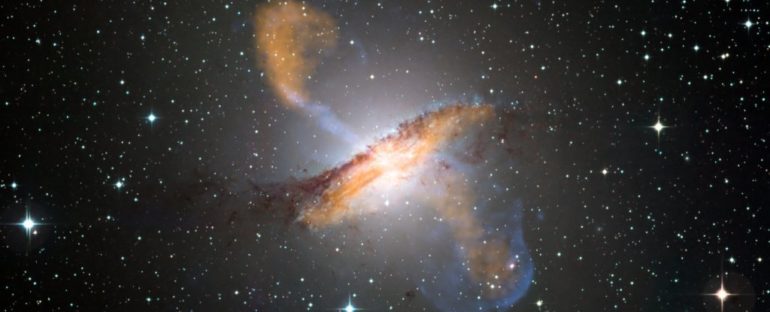Two years ago, the Event Horizon Telescope gave us the first breathtaking image of the supermassive black hole at the centre of the M87 galaxy.
Now, the same telescope has presented an unprecedentedly detailed view of a plasma jet being spat out by the supermassive black hole at the centre of the nearby Centaurus A galaxy.
The newly imaged plasma jet. (Nature Astronomy)
This is a pretty huge announcement for a couple of reasons, so let’s break it down.
First, the image is not only beautiful to look at but mind-boggling to consider – at an average distance of 12 million light-years away, the weirdly shaped Centaurus A galaxy is the closest radio-loud source to Earth. It’s known for its black hole, which spits out powerful plasma jets that we can detect here on Earth.
In the new image, a jet is captured on less than a ‘light-day’ scale, showing us in never-before-seen detail what is happening in these plasma jets.
“Usually we see these jets … at larger scales, and now we’re really peering down into the center of the source,” explains first author Michael Janssen from the Max-Planck-Institut für Radioastronomie, Bonn in Germany, in a video Q&A released alongside the paper.
“Centaurus A is the closest radio galaxy to Earth [and] was actually discovered as one of the first extragalactic radio sources. Because of that feedback we can resolve and see the outflow [of the jet] as it ploughs through the galaxy and what it does to the gas and how it may trigger star formation, which is a very broad research project.”
Second, the high-resolution observations of the jet match what we’d expect to see based on general relativity – meaning once again, the Event Horizon Telescope’s imaging shows Einstein was right.
The theory of general relativity was also confirmed by the observations made of M87* and released back in 2019, but until now it remained to be seen if the same held true for less massive black holes, sucking up less matter.
The black hole at the center of Centaurus A has a mass of around 55 million solar masses (55 million times the mass of our Sun) – around 100 times less massive than M87*.
But it’s also bigger than the EHT’s second primary target, Sagittarius A*, the black hole at the center of our own Milky Way galaxy – which is estimated to be only around 4.1 million times as massive as our Sun.
Sitting in between these masses, the black hole of Centaurus A offered a good mid-point to test Einstein’s theory.
In the latest image, the EHT is unable to image the shadow of the black hole itself – which is what it did in the iconic donut image of M87* from 2019 – but they could peer down as close as 0.6 light-days away from the black hole to see almost to the origin of the jet.
As you can see, the jet looks like a hollow 3D cone with bright edges. Overall, its properties and geometry are very similar to the jets in M87, and also similar to the jets that have been observed coming out of smaller, stellar mass black holes.
“This finding supports the idea that massive black holes are scaled-up versions of their lighter counterparts,” explains a press release.
You can see the latest image in the middle, below (b), when compared to the until-now highest-resolution image of the Centaurus A black hole jet on the left (a), and a jet from M87* as a comparison on the right (c).

Above: (a) The previous highest resolution image of the Centaurus A jet taken with the TANAMI VLBI array. (b) the new EHT image which has a 16x zoom compared to the TANAMI image. (c) The M87 jet for comparison.
The new image also shows us where the jet terminates, which is pretty important, as Janssen explains the outer edges of jets are where particle acceleration likely happens, and are a candidate source for ultra-high-energy cosmic rays. We see actually where the jet terminates.
So what are these plasma jets? They’re released when matter from the galaxy falls toward its black hole – and as a result energy is blasted back out, often at speeds close to the speed of light.
We’ve detected these powerful radio sources from lots of galaxies, but still don’t quite understand how they work.
All of this detail is important, as it’s giving astronomers the data they need to be able to model general relativity in the lab.
“We’re able at this point now to generate effectively a black hole in a box to some extent,” explains researcher Sera Markoff from the University of Amsterdam, who is involved with the EHT project.
But of course there are limitations to what a model can do – as they still don’t understand enough about what forms the shape of these plasma jets.
While the image provides new insight, we still have a lot to learn – like what exactly happens at the boundary between the plasma jet and the black hole itself.
The team has calculated that this is something that they would be able to image in Centaurus A using the EHT at terahertz frequencies, whereas this image was captured at 228 gigahertz. Alternatively, they could use space-based telescopes instead of Earth-based telescopes to get a closer look.
For now, there is plenty of data from this image for astronomers to sink their teeth into, and hopefully this new view will help us get a better understanding of black holes, which remain some of the most mysterious objects in the known Universe.
The research has been published in Nature Astronomy.
Top image Color composite image of Centaurus A and its jets. (ESO/WFI; MPIfR/ESO/APEX/A.Weiss et al.; NASA/CXC/CfA/R.Kraft et al.)



